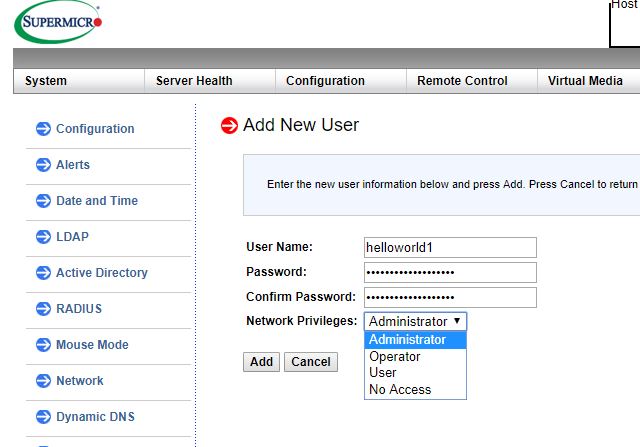Supermicro SYS-2049U-TR4 Management Overview
These days, out of band management is a standard feature on servers. Supermicro offers an industry standard solution for traditional management, including a WebGUI. This is based on the ASPEED AST2500 solution, a leader in the BMC field. The company is also supporting the Redfish management standard. On this motherboard, we see similar features as we would across the Supermicro X11/H11 ranges. That means whether you are using an embedded Intel motherboard or a 4U EPYC storage server, you will have a similar look and feel to the management experience.

In the latest generation of Supermicro IPMI is an HTML5 iKVM. One no longer needs to use a Java console to get remote KVM access to their server.

Currently, Supermicro allows users to utilize Serial-over-LAN, Java or HTML5 consoles from before a system is turned on, all the way into the OS. Other vendors such as HPE, Dell EMC, and Lenovo charge an additional license upgrade for this capability (among others with their higher license levels.) That is an extremely popular feature. One can also perform BIOS updates using the Web GUI, but that feature requires a relatively low-cost license (around $20 street price.) That is a feature we wish Supermicro would include with their systems across product lines.
Supermicro SYS-2049U-TR4 Specs As Tested
We had a fairly standard configuration that we configured from the base barebones that Supermicro sent:
- Server: Supermicro SYS-2049U-TR4
- CPU: 4x Intel Xeon Platinum 8158
- Memory: 48x 32GB DDR4 ECC RDIMMs
- Storage: 4x Seagate Exos 2TB 2.5″, 2x Samsung 960GB U.2 NVMe SSDs, 128GB Supermicro SATA DOM
- PCIe Networking: Mellanox ConnectX-4 Lx
A quick note here: We built the system ourselves which went smoothly, but it took some time to accomplish. Although the cost of the barebones is extremely reasonable at only about $1000 more than its dual-socket Ultra counterpart, Supermicro has started a new trend. The company is only selling these systems as complete systems, not as barebones. That is helping to drive Supermicro’s financial performance. On the other hand, it is a less channel friendly model than Supermicro had previously relied upon for its business.
During our time with the server, we also used up to 4x Intel Xeon Platinum 8180 205W CPUs successfully along with the 1.5TB memory footprint. The system was able to cool every set of CPUs we used in it.
Next, we are going to look at the system topology and latencies before moving on to our standard benchmarks.




They maybe could have noticed that AMD has a socket called TR4 before they used that for their server designation…
Thomas Supermicro was using -TR4 since 2015 in the 2011 era https://www.supermicro.com/products/system/1U/1028/SYS-1028U-TR4_.cfm and they’ve used it on many servers.
Maybe AMD should have noticed Supermicro called Intel platforms -TR4 when they had certain specs
No worries, the prefix still will show clearly the server is AMD, AS-2124…..